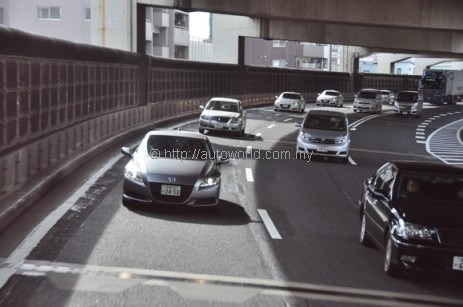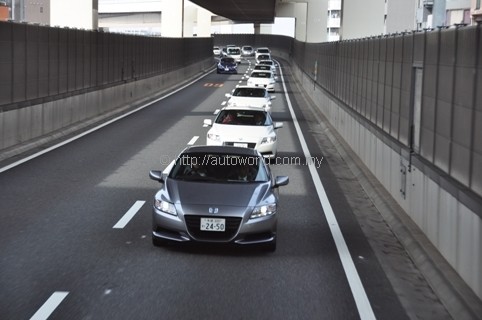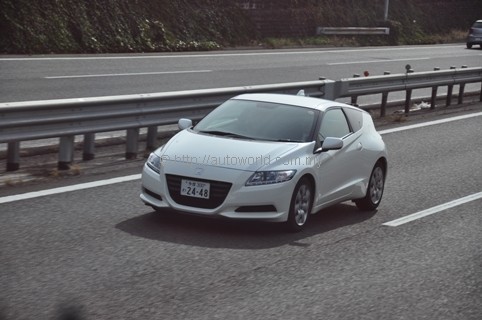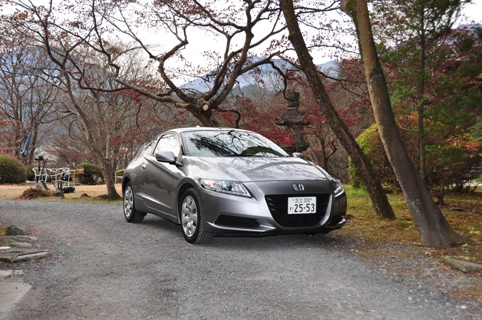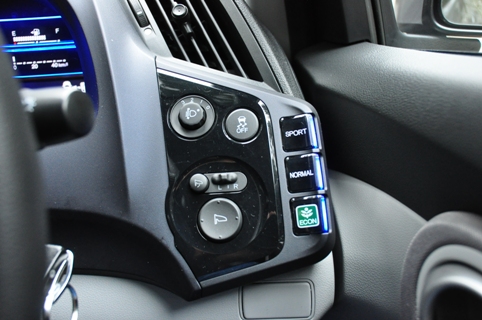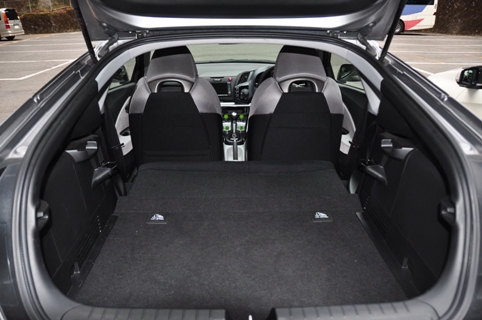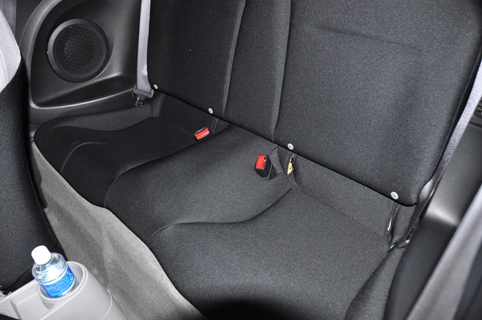Honda CR-Z – Automatic Version Tested in Japan
When the Honda CR-Z was launched a couple of weeks ago in Petaling Jaya, the only transmissions on offer were manual transmissions. Let’s put it on record that I have nothing against manual transmissions, especially if it is a six-speed with close ratios that I can use to the fullest when I am driving in earnest. However, the Malaysian market is skewed towards automatics, although I dare say that there are still many enthusiasts who want a manual for the additional driving pleasure. In the crowded city environments such as Kuala Lumpur, Petaling Jaya, Penang, Ipoh, Johor Bahru, and all the other major towns where traffic jams can be a real pain in the behind, many people are willing to sacrifice just that little bit of performance for an auto.
The CR-Z is such a (depending on where you are coming from), cute, great-looking, sporty car that will appeal to many different types of personalities, not all of which are performance oriented, and together with the enthusiast, will make the CR-Z sell more.
When Honda invited me to come to Japan (I am still here, waiting for the first day of the 2011 Tokyo Motor Show), and quietly said that there might be a test drive of the CR-Z, I expected to test the manual – I was quite thrilled when the cars all turned out to be automatics (CVT’s to be more precise), as I am sure many of our readers are already wondering if there would ever be an auto version of the CR-Z.
The added bonus was that for the first time ever, Honda Malaysia went away from the norm, and managed to arrange a drive that started out from Tokyo city, and went north towards Nikko, a drive that included, other than the mandatory get-out-of-the-city traffic, a short but beautiful stretch of mountainous road during which I was able to put the CR-Z through its paces.
My first concern was with the CVT – whether it would be one of those units where you get a lot of noise and not much go – I was pleasantly surprised as this new generation delivers the drive to the wheels in a much more palatable manner. Checking with the engineers from R & D the next day, I am told that the CVT technologies are being consistently improved, and this latest generation is so much better than the first ones that came out a few years ago.
Just as an aside, CVT’s are known for providing the best output and the best fuel economy when compared to other conventional transmissions, which explains why so many car makers are switching over.
Our test cars were equipped with the same 1.5 litre i-VTEC engine, and the same 124 PS of power, and we were told that they are running RON 95 fuel – so for the record, the power plants are the same. The actual cars that we drove did have some specification differences, such as the trim materials and trim level, including wheel covers over steel rims instead of alloy wheels, but for the purposes of performance comparisons, it would be safe to say that the cars are generally the same in main specs, other than the transmission.
There are three driving modes – ECO, NORMAL and SPORTS. In ECO mode, the engine and transmission control units are programmed to give the best fuel economy possible; in NORMAL mode, it remains a normal hybrid, and gives you a normal type of driving sensation; in SPORTS mode, you get a change in the engine and transmission characteristics to provide a sports type of driving sensation. The three modes are easily activated through push buttons located on the right hand side of the dashboard, within easy reach of ones fingers. What you will note as you switch from ECO to NROMAL is that the engine rpm goes up about 500 rpm, and a further 500 rpm when you switch to SPORTS. Gear change points move up the rev counter with each mode, giving three possible performance levels.
Depending on the traffic situation, I switched between the three modes – on the highways, where the speed limit is 100 km/h, I used the ECO mode – this keeps the engine revolutions low – at that speed, I am barely ticking over at just below 2,000 RPM, and the CR-Z will deliver fantastic fuel economy in this mode. Even when we turned off the highway, I alternated between ECO, NORMAL and SPORT depending on the road conditions. In the town and village areas, I maintained ECO mode, and when I cam to a stop at traffic lights, the engine goes into ‘AUTO STOP’ – this means the engine turns off if I keep my foot on the brakes at a traffic light or anytime I need to stop – it switches on again the moment I left my foot off the brake pedal. Just in case you have forgotten, the CR-Z is a hybrid car, and all the fuel saving attributes of a hybrid are there.
Whenever there is some prospect of driving fast, or when I want to overtake smartly, it is a simple matter of pressing the SPORTS mode button, and transform the CR-Z into a nippy and zippy little sports car. When I got into the mountains, it was SPORTS mode all the way, and I can now safely report that the CR-Z is indeed a fun car to drive. You may lose out a little to the manual CR-Z, but if you like automatics, the CR-Z is good enough. Besides, you get paddle shifters, and they are fun to use.
Handling is beyond reproach – it will make a poor driver look good while making a good driver look professional. You can drive the CR-Z hard, but it can take just about any punishment you or the road can mete out. Through even the sharpest corners of the hill climb (which would make an interesting tarmac rally stage), I found the CR-Z flawless. Those who accelerate through might get a little under steer, which is easy enough to sure, but if you use the right weight transfer techniques, the CR-Z will be a cinch to drive.
The interior is built for the driver and front passenger – great sporty seats, with fore/aft adjustments, rake, seat height and a steering wheel with adjustments for height and reach will give you the ideal sitting position you want, and the bucket contours will hold you securely, leaving your hands free to make the CR-Z do anything you want.
The only weakness I can see in the car is the rear passenger headroom and legroom – in reality it is like the CR-X – my friend used to call the rear seat of the CR-X the ‘one kilometre seat’ – you need to get out after one kilometre – a tall person would not want to be the rear passenger, but small ones may just make it. The CR-Z is made more for two persons, so this is one point you have to bear in mind. The boot is small, but if you need space, the rear seats fold down flat to provide a relative large storage area just behind the front seats.
All things said and done, the CR-Z still is an amazing package that will appeal to the young, and the young at heart – treat it like a two-seater, and you will have no issues with the rear seating. Besides being a great car to drive, when you are sane, it can also save you money in terms of fuel costs. Nowhere else is it possible to find such a great package – it is like having your cake and eating it, the best of two worlds, so to speak.
The final piece of good news is – the auto version will be coming, and the first shipments are expected around March 2012 – so if you want one, you know what to do.




